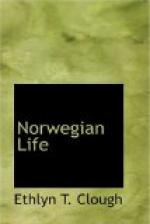Woman, represented by writers like Ellen Key, Selma Lagerloef, Sophie Elkau, Alfhild Agress, Hilma Stanberg, and others, holds a high position in Swedish letters. Ellen Key is an essayist of virile power and argumentative breadth, of superior intellect and unfailing erudition. She is a fearless and unfailing champion of free thought, individualism, and woman’s emancipation. As was said of Madame de Stael, her writings are “the most masculine productions of the faculties of woman.” Selma Lagerloef occupies as a novelist a position of her own. Her style and her manner in fiction are unique. Symbolism and allegory are blended in it with the most realistic pictures of everyday life. She thinks in parables, and describes realities, and the realities convey the moral teachings of parables. With something of the peculiar power of George Eliot in the delineation of character, she makes each humble life preach some great moral truth. Her latest book, Jerusalem, is one of extraordinary fascination, created quite a sensation in Sweden, and places Selma Lagerloef quite among the foremost writers of the day.
It may in general be said of Swedish writers that they have a high idea of their calling. Few, if any, have accepted as their sole function the idealization of form. They hold mostly that the highest aim of art should be to teach and elevate, to destroy prejudice and conventionality, and indicate, in so far as it is possible, the solution of moral problems through the creative faculty of inspired productiveness. The wish to inculcate action, the energy that is born of enthusiasm, the chivalry that is inspired by high ideals and unselfish motives. Raised thus from the region of mere chronicles of human passions, of woman’s frailty and man’s baseness, and exercising themselves with the political, social, and religious problems of the day, these works of imagination have become, alongside the Press, a powerful factor in the development of modern thought.[f]
CHAPTER VII
GOVERNMENT AND POLITICS OF NORWAY AND SWEDEN
Only for the past three years has Norway had an independent political life, and so few changes in local government have so far been made under the new king that it will be profitable, in this chapter, to take up the government and political life as it existed under the united Constitutional Monarchy of Norway and Sweden. In fact, it is no different than at that time, except that each has its separate king. In internal rule, the two countries were always separate, except in matters that pertained to the common weal of both. Thus, the Swedish Minister of Foreign Affairs had charge of the United Kingdoms, and, as previously stated, this was the rock on which the Union finally split.




